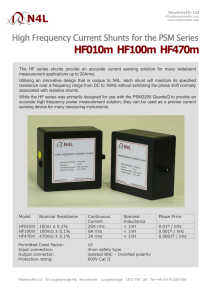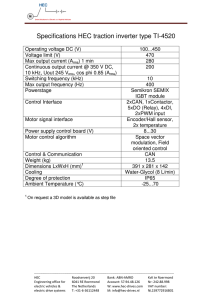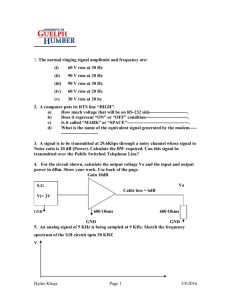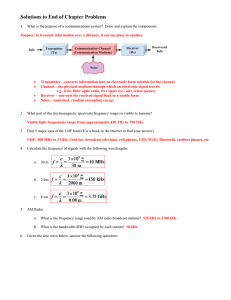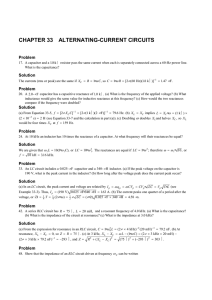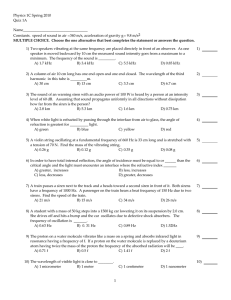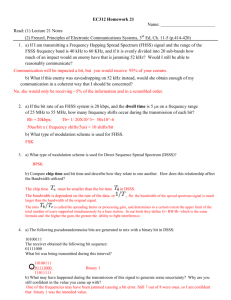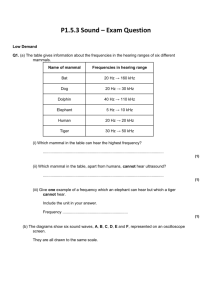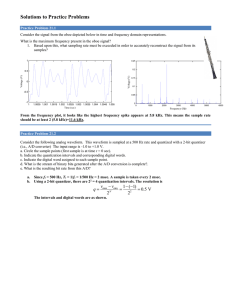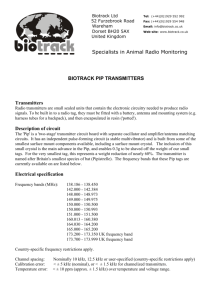RLC Series Circuits ENGINEERING-43 Lab-15 – ENGR-43 Lab-15
advertisement
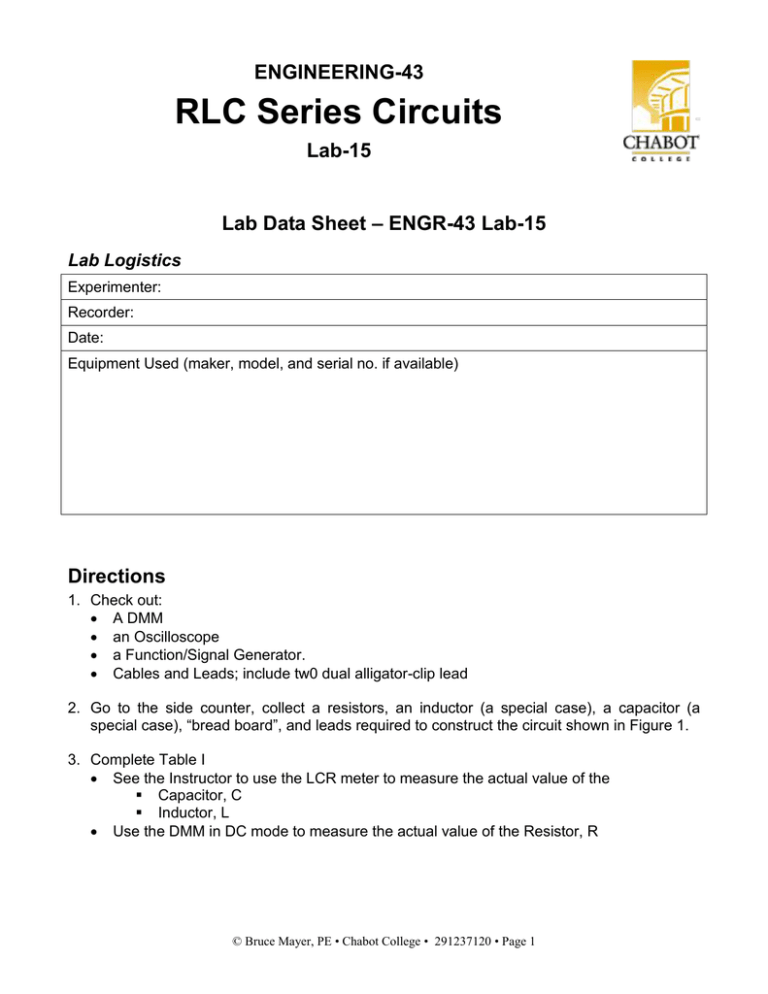
ENGINEERING-43 RLC Series Circuits Lab-15 Lab Data Sheet – ENGR-43 Lab-15 Lab Logistics Experimenter: Recorder: Date: Equipment Used (maker, model, and serial no. if available) Directions 1. Check out: A DMM an Oscilloscope a Function/Signal Generator. Cables and Leads; include tw0 dual alligator-clip lead 2. Go to the side counter, collect a resistors, an inductor (a special case), a capacitor (a special case), “bread board”, and leads required to construct the circuit shown in Figure 1. 3. Complete Table I See the Instructor to use the LCR meter to measure the actual value of the Capacitor, C Inductor, L Use the DMM in DC mode to measure the actual value of the Resistor, R © Bruce Mayer, PE • Chabot College • 291237120 • Page 1 Figure 1 • RLC Series Circuit. Vs = 6V0° (12 Vpp), f per Table II, Table IV, Table V. L = 100 mH, C = 22 nF, R = 2.5-4.1 kΩ (3.3 kΩ nominally). Table I – Measure C, L, and R with The LCR-Meter, and DMM in the DC mode, respectively Digital-Meter Actual-Values C= L= R= 4. Use the LCR meter values to calculate the “Center Frequency”, ωc (or fc), for this 2nd order circuit. The Center frequency for this circuit is defined as that value of ω or f that results in EQUAL REACTANCES for both the inductor and capacitor. Recall from the TextBook that reactance is the magnitude of the impedance for a capacitor or inductor. Mathematically ZC jX C 1 1 XC jC C Z L jX L jL X L L © Bruce Mayer, PE • Chabot College • 291237120 • Page 2 To find ωc Equate the |XC| and XL yielding cL and 1 c C c2 1 LC f c c 2 Use the LCR Meter values for L & C to calculate fc fc = 5. Use the DMM and Scope to make the Measurements and Calculations needed to complete Table II Measure rms Quantities by DMM in AC Mode Using measured values of Vrms & Irms find: XL = VL,rms/IL,rms XC = −[VC,rms/IC,rms] From measured rms values Calculate L & C from the expressions for XL & XC. Recall that: XL = VL,rms/IL,rms = L XC = −[VC,rms/IC,rms] = −1/(C) 6. Make the Measurements and Calculations needed to complete: Table III (Calculations only) Table IV Make Scope Measurements using the techniques from labs 16 & 17. o Be sure to adjust the BOTH the FREQUENCY and APLITUDE upon any frequency-change Table V Use the Scope CURSOR function to measure TIME Differences 7. Return all lab hardware to the “as-found” condition Table II – Inductance and Capacitance Measurements and Calculation Measure rms Quantities by DMM in AC Mode Calculate XC and XL by the methods described in item Error! Reference source not found. above For XL assume that the series resistance of the coil is negligible Frequency, f IT,rms VC, rms VL,rms VR,rms XC XL 1 kHz 3.333 kHz 10 kHz © Bruce Mayer, PE • Chabot College • 291237120 • Page 3 L calc C calc Avg = Table III – Series RL Impedance Calculations Use R from Table I Use The Average Values for L and C from Table II State ZTOTAL in Rectangular Form Value Determination R XL XC ZTOTAL Calculated @ 0.1 kHz Calculated @ 0.4 kHz Calculated @ 1.25 kHz Calculated @ 2.5 kHz Calculated @ 8 kHz Calculated @ 25 kHz Calculated @ 80 kHz Table IV – Series RLC Potential Measurements Sweep. Vs = 12 Vpp Use the Scope’s MATH function (CH1 – CH2) to Measure VC and VL as indicated in Figure 2. Observe that VB is equal to VR. Note whether voltage quantities are Peak-to-Peak or Amplitude measurements Frequency, f VC = VS -VA VL = VA -VB 0.1 kHz 0.4 kHz 1.25 kHz 2.5 kHz 8 kHz 25 kHz 80 kHz © Bruce Mayer, PE • Chabot College • 291237120 • Page 4 VR = V B Figure 2 • RLC Series Circuit differential potential measurements. Circuit parameters the same as Figure 1. Table V – Series RLC Phase Angle Measurements and Calculations As indicated in Figure 3 use the Scope to Measure the Phase Differences at nodes A&B Relative to the BaseLine; VS = 6Vamplitude0°, , in terms of TIME at A&B Convert the Phase-TIME differences, A,meas and B,meas to Phase-ANGLE differences, A,meas and B,meas using the Signal Period, T, to determine the phase ANGLE, , in DEGREES (°) relative to the base-line value for Vs: LEAD 360 sec T sec LAG Frequency, f A,meas B,meas A,meas 0.1 kHz 0.4 kHz 1.25 kHz 2.5 kHz 8 kHz 25 kHz 80 kHz © Bruce Mayer, PE • Chabot College • 291237120 • Page 5 B,meas Figure 3 • RLC Series Circuit phase angle measurements. Circuit parameters the same as Figure 1. Table VI – Series RLC Phase Angle Voltage Divider Calculations and Comparisons Use the reactance values in Table II and Table III, along with voltage-divider methodology, to calculate the Phase Angle, , at A&B in DEGREES. Use the measurements for from Table V to determine the % for the Phase Angles. o The CALCULATED values should serve as the BASELINE for the Δ% calculation(s) as -% = 100x(meas – calc)/calc Frequency, f A,calc B,calc A-% 0.1 kHz 0.4 kHz 1.25 kHz 2.5 kHz 8 kHz 25 kHz 80 kHz © Bruce Mayer, PE • Chabot College • 291237120 • Page 6 B-% 8. Use MATLAB or EXCEL to create two SemiLog plots of the data contained in the data tables. In both plots the frequency, f, will be plotted on the Logarithmic scale Plot-1 from Table IV Independent variable = log(f) THREE dependent variables on the same plot: VC, VL , and VR Plot-2 Independent variable = log(f) FOUR Dependent variables on the same plot: A,meas, B,meas, A,calc, B,calc Attach both plots to this lab report ANALYZE the trends shown in the plots, and comment on the physical CAUSE of the observed trends HINT: Consider the Behavior of the Circuit in these extreme cases o →0 o →∞ Run Notes/Comments Print Date/Time = 29-May-16/03:59 © Bruce Mayer, PE • Chabot College • 291237120 • Page 7
